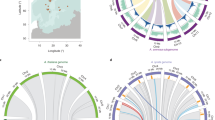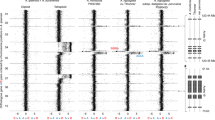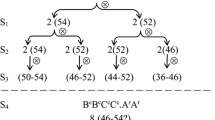Abstract
Polyploidy is known to be common in plants and recent work has focused on the rapid changes in genome structure and expression that occur upon polyploidization. In Arabidopsis, much of this work has been done on a synthetic allotetraploid obtained by crossing a tetraploid Arabidopsis thaliana (2n = 4x = 20) with A. arenosa (2n = 4x = 32). To explore an alternative route to polyploidy in this model species, we have developed a synthetic allopolyploid by crossing two diploid species: A. thaliana (2n = 2x = 10) and Arabidopsis lyrata subsp. petraea (2n = 2x = 16). F1 hybrids were easy to obtain and phenotypically more similar to A. lyrata. Spontaneous chromosome doubling events occurred in about 25% of the F1s, thus restoring fertility. The resulting allotetraploids (2n = 26) exhibited many genomic changes typically reported upon polyploidization. Nucleolar dominance was observed as only the A. lyrata rDNA loci were expressed in the F1 and allotetraploids. Changes in the degree of methylation were observed at almost 25% of the loci examined by MSAP analysis. Finally, structural genomic alterations did occur as a large deletion covering a significant portion of the upper arm of chromosome II was detected but no evidence of increased mobility of transposons was obtained. Such allotetraploids derived from two parents with sequenced (or soon to be sequenced) genomes offer much promise in elucidating the various changes that occur in newly synthesized polyploids.





Similar content being viewed by others
References
Adams KL, Wendel JF (2005) Polyploidy and genome evolution in plants. Curr Opin Plant Biol 8:135–141
Adams KL, Percifield R, Wendel JF (2004) Organ-specific silencing of duplicated genes in a newly synthesized cotton allotetraploid. Genetics 168:2217–2226
Albertin W, Balliau T, Brabant P, Chèvre AM, Eber F, Malosse C, Thiellement H (2006) Numerous and rapid nonstochastic modification of gene products in newly synthesized Brassica napus allotetraploids. Genetics 173:1101–1113
Al-Shehbaz IA, O’Kane SL Jr (2002) Taxonomy and phylogeny of Arabidopsis (Brassicaceae). In: Somerville CR, Meyerowitz EM (eds) The Arabidopsis book. American Society of Plant Biologists, Rockville, pp 1–22 Available via DIALOG. http://aspb.org/publications/arabidopsis. Cited 26 January 2007
Balañá-Alcaide D, Ramos-Onsins E, Boone Q, Aguadé M (2006) Highly structured nucleotide variation within and among Arabidopsis lyrata populations at the FAH1 and DFR gene regions. Mol Ecol 15:2059–2068
Beaulieu J, Jean M, Belzile F (2007) Linkages maps for Arabidopsis lyrata ssp. lyrata and A. lyrata ssp. petraea combining anonymous and A. thaliana-derived markers. Genome 50:142–150
Beck JB, Al-Shehbaz IA, O’Kane SL Jr, Schaal BA (2007) Further insights into the phylogeny of Arabidopsis (Brassicaceae) from nuclear Atmyb2 flanking sequence. Mol Phylogenet Evol 42:122–130
Caputo D, Frusciante L, Peloquin SJ (2003) The role of 2n gametes and endosperm balance number in the origin and evolution of polyploids in tuber-bearing Solanums. Genetics 163:287–294
Carling J (2004) Available via DIALOG. http://www.triticarte.com.au/content/DNA-preparation.html. Cited 5 March 2007
Cermeño MC, Orellana J, Santos JL, Lacadena JR (1984) Nucleolar organizer activity in wheat, rye and derivatives analyzed by silver-staining procedure. Chromosoma (Berl) 89:370–376
Cervera MT, Ruiz-Garcia L, Martinez-Zapater JM (2002) Analysis of DNA methylation in Arabidopsis thaliana based on methylation-sensitive AFLP markers. Mol Genet Genomics 268:543–552
Chan SW-L, Henderson IR, Jacobsen SE (2005) Gardening the genome: DNA methylation in Arabidopsis thaliana. Nature Rev Genet 6:351–360
Chen ZJ, Ni Z (2006) Mechanisms of genomic rearrangements and gene expression changes in plant polyploids. Bioessays 28:240–252
Chen ZJ, Pikaard CS (1997) Transcriptional analysis of nucleolar dominance in polyploid plants: biased expression/silencing of progenitor rRNA genes is developmentally regulated in Brassica. Proc Natl Acad Sci USA 94:3442–3447
Chen ZJ, Comai L, Pikkard CS (1998) Gene dosage and stochastic effects determine the severity and direction of uniparental ribosomal RNA gene silencing (nucleolar dominance) in Arabidopsis allopolyploids. Proc Natl Acad Sc USA 95:14891–14896
Chen ZJ, Wang J, Tian L, Lee HS, Wang JJ, Chen M, Lee JJ, Joesefsson C, Madlung A, Watson B, Lippman Z, Vaughn M, Pires JC, Colot V, Doerge RW, Martienssen RA, Comai L, Osborn TC (2004) The development of an Arabidopsis model system for genome-wide analysis of polyploidy effects. Biol J Linn Soc 82:689–700
Chen M, Ha M, Lackey E, Wang J, Chen ZJ (2008) RNAi of met1 reduces DNA methylation and induces genome-specific changes in gene expression and centromeric small RNA accumulation in Arabidopsis allopolyploids. Genetics 178:1845–1858
Clauss MJ, Cobban H, Mitchell-Olds T (2002) Cross-species microsatellite markers for elucidating population genetic structure in Arabidopsis and Arabis (Brassicaceae). Mol Ecol 11:591–601
Comai L (2005) The advantages and disadvantages of being polyploid. Nat Rev Genet 6:836–846
Comai L, Tyagi AP, Winter K, Holmes-Davis R, Reynolds SH, Stevens Y, Byers B (2000) Phenotypic instability and rapid gene silencing in newly formed Arabidopsis allotetraploids. Plant Cell 12:1551–1567
Feldman M, Liu B, Segal G, Abbo S, Levy AA, Vega JM (1997) Rapid elimination of low copy DNA sequences in polyploid wheat: a possible mechanism for differentiation of homoeologous chromosomes. Genetics 147:1381–1387
Gehring M, Henikoff S (2007) DNA methylation dynamics in plant genomes. Biochim Biophys Acta 1769:276–286
Hansson B, Kawabe A, Preuss S, Kuittinen H, Charlesworth D (2006) Comparative gene mapping in Arabidopsis lyrata chromosomes 1 and 2 and the corresponding A. thaliana chromosome 1: recombination rates, rearrangements and centromere location. Genet Res (Camb) 87:75–85
Hegarty MJ, Barker GL, Wilson ID, Abbott RJ, Edwards KJ, Hiscock SJ (2006) Transcriptome shock after interspecific hybridization in Senecio is ameliorated by genome duplication. Curr Biol 16:1652–1659
Joint Genome Institute of the Department of Energy (2008) Status of the Arabidopsis lyrata whole genome sequencing project. http://genome.jgi-psf.org/Araly1/Araly1.info.html. Cited 28 November 2008
Kashkush K, Feldman M, Levy AA (2002) Gene loss, silencing and activation in a newly synthesized wheat allotetraploid. Genetics 160:1651–1659
Koch MA, Haubold B, Michell-Olds T (2000) Comparative evolutionary analysis of chalcone synthase and alcohol deshydrogenase loci in Arabidopsis, Arabis and related genera (Brassicaceae). Mol Biol Evol 17:1483–1498
Kuittinen H, de Haan AA, Vogl C, Oikarinen S, Leppala J, Koch M, Mitchell-Olds T, Langley CH, Savolainen O (2004) Comparing the linkage maps of the close relatives Arabidopsis lyrata and A. thaliana. Genetics 168:1575–1584
Lawrence RJ, Earley K, Pontes O, Silva M, Chen ZJ, Neves N, Viegas W, Pikaard CS (2004) A concerted DNA methylation/histone methylation switch regulates rRNA gene dosage control and nucleolar dominance. Mol Cell 13:599–609
Le QH, Bureau T (2004) Prediction and quality assessment of transposon insertion display data. Biotechniques 36:222–226
Lee HS, Chen ZJ (2001) Protein-coding genes are epigenetically regulated in Arabidopsis polyploids. Proc Natl Acad Sci USA 98:6753–6758
Liu B, Wendel JF (2000) Retroelement activation followed by rapid repression in interspecific hybrid plants. Genome 43:874–880
Liu B, Wendel JF (2003) Epigenetic phenomena and the evolution of plant allopolyploids. Mol Phylogenet Evol 29:365–379
Liu B, Brubaker CL, Mergeai G, Cronn RC, Wendel JF (2001) Polyploid formation in cotton is not accompanied by rapid genomic changes. Genome 44:321–330
Lukens LN, Pires JC, Leon E, Vogelzang R, Oslach L, Osborn T (2006) Pattern of sequence loss and cytosine methylation within a population of newly resynthesized Brassica napus allopolyploids. Plant Physiol 140:336–348
Ma XF, Gustafson JP (2006) Timing and rate of genome variation in triticale following allopolyploidization. Genome 49:950–958
Madlung A, Masuelli RW, Watson B, Reynolds SH, Davison J, Comai L (2002) Remodeling of DNA methylation and phenotypic and transcriptional changes in synthetic Arabidopsis allotetraploids. Plant Physiol 129:733–746
Madlung A, Tyagi AP, Watson B, Jiang H, Kagochi T, Doerge RW, Martienssen R, Comai L (2004) Genomic changes in synthetic Arabidopsis polyploids. Plant J 41:221–230
Meyers LA, Levin DA (2006) On the abundance of polyploids in flowering plants. Evolution 60:1198–1206
Nasrallah ME (2000) Arabidopsis species hybrids—emerging model systems for the analysis of species differences. J Plant Growth Regul 19:326–333
Nasrallah ME, Yogeeswaran K, Snyder S, Nasrallah JB (2000) Arabidopsis species hybrids in the study of species differences and evolution of amphiploidy in plants. Plant Physiol 124:1605–1614
O’Kane SL Jr, Al-Shehbaz IA (2003) Phylogenetic position and generic limits of Arabidopsis (Brassicaceae) based on sequences of nuclear ribosomal DNA. Ann Mo Bot Gard 90:603–612
Otto SP, Whitton J (2000) Polyploid incidence and evolution. Annu Rev Genet 34:410–437
Pikaard CS (2000) The epigenetics of nucleolar dominance. Trends Genet 16:495–500
Pontes O, Neves N, Silva M, Lewis MS, Madlung A, Comai L, Viegas W, Pikaard CS (2004) Chromosomal locus rearrangements are a rapid response to formation of the allotetraploid Arabidopsis suecica genome. Proc Natl Acad Sci USA 101:18240–18245
Ramsey J, Schemske DW (1998) Pathways, mechanisms, and rates of polyploid formation in flowering plants. Ann Rev Ecol Syst 29:467–501
Salmon A, Ainouche ML, Wendel F (2005) Genetic and epigenetic consequences of recent hybridization and polyploidy in Spartina (Poaecae). Mol Ecol 14:1163–1175
Shaked H, Kashkush K, Ozkan H, Feldman M, Levy AA (2001) Sequence elimination and cytosine methylation are rapid and reproducible responses of the genome to wide hybridization and allopolyploidy in wheat. Plant Cell 13:1749–1759
Soltis DE, Soltis PE, Tate JA (2003) Advances in the study of polyploidy since plant speciation. New Phytol 161:173–191
Song K, Lu P, Tang K, Osborn TC (1995) Rapid genome change in synthetic polyploids of Brassica and its implications for polyploid evolution. Proc Natl Acad Sci USA 92:7719–7723
Stronghill PE, Hasenkampf CA (2007) Analysis of substage associations in prophase I of meiosis in floral buds of wild-type Arabidopsis thaliana (Brassicaceae). Am J Bot 94:2063–2067
Vos P, Hogers R, Bleeker M, Reijans M, van de Lee T, Hornes M, Frijters A, Pot J, Peleman J, Kuiper M, Zabea M (1995) AFLP: a new technique for DNA fingerprinting. Nucleic Acids Res 23:4407–4414
Wallace H, Langridge WHR (1971) Differential amphiplasty and the control of ribosomal RNA synthesis. Heredity 27:1–13
Wang J, Tian L, Madlung A, Lee HS, Chen M, Lee JJ, Watson B, Kagochi T, Comai L, Chen ZJ (2004) Stochastic and epigenetic changes of gene expression in Arabidopsis polyploids. Genetics 167:1961–1973
Wang J, Tian L, Lee HS, Wei NE, Jiang H, Watson B, Madlung A, Osborn TC, Doerge RW, Comai L, Chen ZJ (2006) Genomewide nonadditive gene regulation in Arabidopsis allotetraploids. Genetics 172:507–517
Wright SI, Le QH, Schoen DJ, Bureau TE (2001) Population dynamics of an Ac-like transposable element in self- and cross-pollinating Arabidopsis. Genetics 158:1279–1288
Yogeeswaran K, Frary A, York TL, Amenta A, Lesser AH, Nasrallah JB, Tanksley SD, Nasrallah ME (2005) Comparative genome analyses of Arabidopsis spp: inferring chromosomal rearrangement events in the evolutionary history of A. thaliana. Genome Res 15:505–515
Acknowledgments
We wish to thank two reviewers for many helpful comments and suggestions. We also thank Dr. Clare Hasenkampf and Patricia Stronghill (University of Toronto-Scarborough) for their help with the cytological analysis of flower buds. This work was supported in part by a graduate studentship from the Fonds québécois de la recherche sur la nature et les technologies to J. Beaulieu. This work was also supported by a research grant from the Natural Sciences and Engineering Research Council to F. Belzile.
Author information
Authors and Affiliations
Corresponding author
Additional information
Communicated by S. Hohmann.
Rights and permissions
About this article
Cite this article
Beaulieu, J., Jean, M. & Belzile, F. The allotetraploid Arabidopsis thaliana–Arabidopsis lyrata subsp. petraea as an alternative model system for the study of polyploidy in plants. Mol Genet Genomics 281, 421–435 (2009). https://doi.org/10.1007/s00438-008-0421-7
Received:
Accepted:
Published:
Issue Date:
DOI: https://doi.org/10.1007/s00438-008-0421-7




